Topexcelgrades
On this page, you find all documents, package deals, and flashcards offered by seller topexcelgrades.
- 29
- 0
- 0
Community
- Followers
- Following
29 items
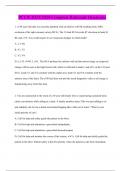
PCCN 2023/2024 Complete Rationale Questions
1. A 49-year-old male was recently admitted with an inferior wall MI resulting from 100% occlusion of the right coronary artery (RCA). The 12-lead ECG reveals ST elevation in leads II, III, and a VF. You would expect to see reciprocal changes in which leads? A. I, a VR B. V1, V2 C. V3, V4 D. I, a VL D. I, aVL. The RCA perfuses the inferior wall and the mirror image or reciprocal change will be seen in the high lateral wall, which is reflected in leads I, and aVL on the 12-Lead ECG. Leads V1 ...
- Exam (elaborations)
- • 16 pages •
1. A 49-year-old male was recently admitted with an inferior wall MI resulting from 100% occlusion of the right coronary artery (RCA). The 12-lead ECG reveals ST elevation in leads II, III, and a VF. You would expect to see reciprocal changes in which leads? A. I, a VR B. V1, V2 C. V3, V4 D. I, a VL D. I, aVL. The RCA perfuses the inferior wall and the mirror image or reciprocal change will be seen in the high lateral wall, which is reflected in leads I, and aVL on the 12-Lead ECG. Leads V1 ...
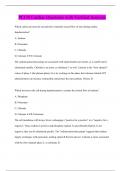
PCCN Cardiac Questions with Verified Answers
Which cation activates the second (slow-channel) inward flow of ions during cardiac depolarization? A. Sodium B. Potassium C. Chloride D. Calcium D. Calcium The sodium-potassium pumps are associated with rapid channel movement, so A and B can be eliminated initially. Chloride is an anion, so eliminate C as well. Calcium is the "slow channel" cation of phase 2 (the plateau phase). It is by working on this phase that calcium chloride IVP administration can increase contractility and protect...
- Exam (elaborations)
- • 60 pages •
Which cation activates the second (slow-channel) inward flow of ions during cardiac depolarization? A. Sodium B. Potassium C. Chloride D. Calcium D. Calcium The sodium-potassium pumps are associated with rapid channel movement, so A and B can be eliminated initially. Chloride is an anion, so eliminate C as well. Calcium is the "slow channel" cation of phase 2 (the plateau phase). It is by working on this phase that calcium chloride IVP administration can increase contractility and protect...
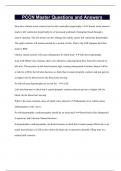
PCCN Master Questions and Answers
How does chronic aortic stenosis lead to left ventricular hypertrophy? Chronic aortic stenosis leads to left ventricular hypertrophy bc of increased workload of pumping blood through a narrow opening. The left atrium can also enlarge but mainly causes left ventricular hypertrophy. The right ventricle will remain normal for a period of time. That's why LHF happens first then leads to RHF. Chronic mitral stenosis will cause enlargement in which area? Left atria hypertrophy. In pt with Mitral v...
- Exam (elaborations)
- • 42 pages •
How does chronic aortic stenosis lead to left ventricular hypertrophy? Chronic aortic stenosis leads to left ventricular hypertrophy bc of increased workload of pumping blood through a narrow opening. The left atrium can also enlarge but mainly causes left ventricular hypertrophy. The right ventricle will remain normal for a period of time. That's why LHF happens first then leads to RHF. Chronic mitral stenosis will cause enlargement in which area? Left atria hypertrophy. In pt with Mitral v...
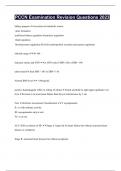
PCCN Examination Revision Questions 2023
kidney purpose excretion of metabolic wastes urine formation acid-base balance regulation electrolyte regulation fluid regulation blood pressure regulation (RAAS) erythropoietin secretion and anemia regulation chloride range 96-106 Ischemic stroke and HTN tx HTN only if SBP>220 or DBP >140 unless had tPA then SBP: >185 or DBP >110 Normal BNP level <100 pg/mL positive hepatojugular reflex in setting of edema push and hold on right upper quadrant over liver if...
- Exam (elaborations)
- • 14 pages •
kidney purpose excretion of metabolic wastes urine formation acid-base balance regulation electrolyte regulation fluid regulation blood pressure regulation (RAAS) erythropoietin secretion and anemia regulation chloride range 96-106 Ischemic stroke and HTN tx HTN only if SBP>220 or DBP >140 unless had tPA then SBP: >185 or DBP >110 Normal BNP level <100 pg/mL positive hepatojugular reflex in setting of edema push and hold on right upper quadrant over liver if...
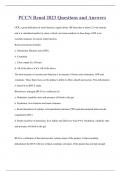
PCCN Renal 2023 Questions and Answers
GFR, a good indication of renal function, equals about 180 liters/day or about 125 mL/minute and is a calculated number by many critical care team members to dose drugs. GFR is an excellent measure of current renal function. Renal assessment includes: a. Glomerular filtration rate (GFR) b. Creatinine c. Urine output for 24 hours d. All of the above d. All of the above The best measure of current renal function is to measure 24-hour urine formation, GFR and creatinine. These three focus on ...
- Exam (elaborations)
- • 17 pages •
GFR, a good indication of renal function, equals about 180 liters/day or about 125 mL/minute and is a calculated number by many critical care team members to dose drugs. GFR is an excellent measure of current renal function. Renal assessment includes: a. Glomerular filtration rate (GFR) b. Creatinine c. Urine output for 24 hours d. All of the above d. All of the above The best measure of current renal function is to measure 24-hour urine formation, GFR and creatinine. These three focus on ...
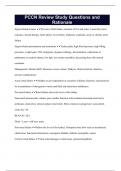
PCCN Review Study Questions and Rationale
Hypervolemia Causes Excessive fluid intake, retention of NA and water. Caused by stress response, steroid therapy, heart failure, liver failure, nephrotic syndrome, acute or chronic renal failure Hypervolemia presentation and treatments Tachycardia, high blood pressure, high filling pressures, weight gain, JVD, tachypnea, dyspnea, lethargy, disorientation, indications of pulmonary or cerebral edema, low hgb, low serum osmolality, decreasing bun with normal creatinine Managmenet: Monitor I&O, D...
- Exam (elaborations)
- • 16 pages •
Hypervolemia Causes Excessive fluid intake, retention of NA and water. Caused by stress response, steroid therapy, heart failure, liver failure, nephrotic syndrome, acute or chronic renal failure Hypervolemia presentation and treatments Tachycardia, high blood pressure, high filling pressures, weight gain, JVD, tachypnea, dyspnea, lethargy, disorientation, indications of pulmonary or cerebral edema, low hgb, low serum osmolality, decreasing bun with normal creatinine Managmenet: Monitor I&O, D...
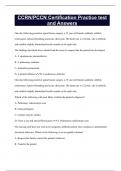
CCRN/PCCN Certification Practice
One day following posterior spinal fusion surgery a 35 year old female suddenly exhibits restlessness, labored breathing and acute chest pain. Her heart rate is 122/min., she is afebrile, and exhibits slightly diminished breath sounds on the right side. The findings described above should lead the nurse to suspect that the patient has developed: A. A spontaneous pneumothorax B. A pulmonary embolus C. Aspiration pneumonia D. A pleural effusion B. A pulmonary embolus One day following poster...
- Exam (elaborations)
- • 17 pages •
One day following posterior spinal fusion surgery a 35 year old female suddenly exhibits restlessness, labored breathing and acute chest pain. Her heart rate is 122/min., she is afebrile, and exhibits slightly diminished breath sounds on the right side. The findings described above should lead the nurse to suspect that the patient has developed: A. A spontaneous pneumothorax B. A pulmonary embolus C. Aspiration pneumonia D. A pleural effusion B. A pulmonary embolus One day following poster...
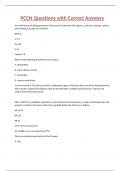
PCCN Questions with Correct Answers
A pt with history of taking gentamicin (Garamycin) is admitted with oliguria, confusion, lethargy, nausea and vomiting. Lab data are as follows BUN 26 Cr 1.6 Na 130 K 4.9 Calcium 7.8 Which of the following should the nurse suspect A. dehydration B. acute tubular necrosis C. GI infection D. chronic renal failure Correct Answer B. This pt has received a nephrotoxic agent, which puts the pt at risk for development of ATN. Lab data support this diagnosis with an elevated BUN, creatinine ...
- Exam (elaborations)
- • 19 pages •
A pt with history of taking gentamicin (Garamycin) is admitted with oliguria, confusion, lethargy, nausea and vomiting. Lab data are as follows BUN 26 Cr 1.6 Na 130 K 4.9 Calcium 7.8 Which of the following should the nurse suspect A. dehydration B. acute tubular necrosis C. GI infection D. chronic renal failure Correct Answer B. This pt has received a nephrotoxic agent, which puts the pt at risk for development of ATN. Lab data support this diagnosis with an elevated BUN, creatinine ...
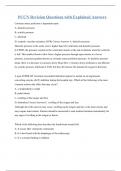
PCCN Revision Questions with Explained Answers
Coronary artery perfusion is dependent upon: A. diastolic pressure B. systolic pressure C. afterload D. systemic vascular resistance (SVR) Correct Answers A. diastolic pressure Diastolic pressure in the aortic root is higher than left ventricular end-diastolic pressure (LVEDP), the pressure exerted on the ventricular muscle at the end of diastole when the ventricle is full. This enables blood to flow from a higher pressure through open arteries to a lower pressure, a pressure gradient known...
- Exam (elaborations)
- • 43 pages •
Coronary artery perfusion is dependent upon: A. diastolic pressure B. systolic pressure C. afterload D. systemic vascular resistance (SVR) Correct Answers A. diastolic pressure Diastolic pressure in the aortic root is higher than left ventricular end-diastolic pressure (LVEDP), the pressure exerted on the ventricular muscle at the end of diastole when the ventricle is full. This enables blood to flow from a higher pressure through open arteries to a lower pressure, a pressure gradient known...
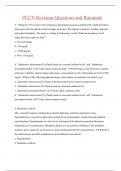
PCCN Revision Questions and Rationale
b. <50mg/dL A nurse in the emergency department assesses a patient with a hand laceration and notices that the patient smells strongly of alcohol. The patient is diabetic, irritable, and pale and reports headache. The nurse is waiting for laboratory results. What serum glucose level might the nurse expect to find? a. 50 to 60 mg/dL b. <50 mg/dL c. >1000 mg/dL d. 80 to 110 mg/dL d. "Administer intravenous (IV) fluids based on corrected sodium levels" and "Administer prescribed ...
- Exam (elaborations)
- • 6 pages •
b. <50mg/dL A nurse in the emergency department assesses a patient with a hand laceration and notices that the patient smells strongly of alcohol. The patient is diabetic, irritable, and pale and reports headache. The nurse is waiting for laboratory results. What serum glucose level might the nurse expect to find? a. 50 to 60 mg/dL b. <50 mg/dL c. >1000 mg/dL d. 80 to 110 mg/dL d. "Administer intravenous (IV) fluids based on corrected sodium levels" and "Administer prescribed ...
